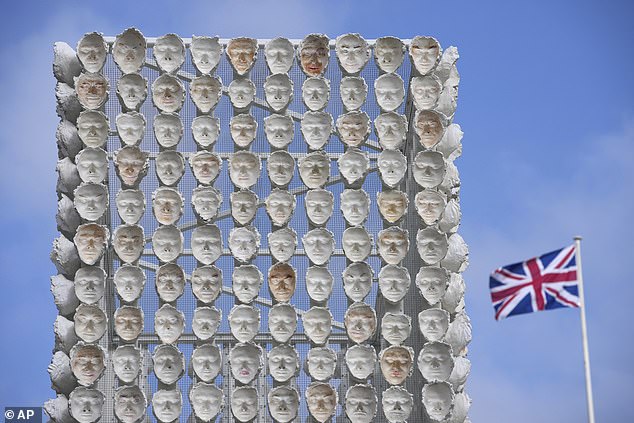Trafalgar Square’s fourth plinth has been a center of artistic debate and admiration for over 25 years.
Originally built in 1841 to display a statue of William IV, the plinth now serves a very different purpose.
Since 1999, it has showcased a rotation of contemporary art, giving both tourists and Londoners something new and often thought-provoking to discuss.
From giant thumbs to quirky cockerels, the plinth has become a canvas for artists who aim to challenge, confuse, and inspire.
The Latest Installation: A Thousand Faces
This year’s artwork, Mil Veces un Instante (A Thousand Times in an Instant), by Mexican artist Teresa Margolles, takes the stage with 726 plaster face casts of transgender, non-binary, and gender non-conforming individuals.
The installation weighs over 7,000 lbs and is set to gradually weather away over time, a deliberate reflection on the fragility and transient nature of life.
The faces will fade as wind and rain erode them, leaving behind an “anti-monument,” as the artist describes it.
Mixed Reactions from the Public
The latest addition has stirred conversation both online and at the square itself.
Some visitors, like Callum Murphy, 30, voiced confusion.
He described it as looking like “papier-mâché” and felt it didn’t match the grandeur of Trafalgar Square’s historic surroundings.
Others, like Matt, a 53-year-old engineer, saw deeper connections, likening it to themes from Star Trek that challenge traditional notions of identity.
Student Sophia, 25, appreciated its subtlety, saying it blended well with the environment and encouraged people to take a closer look.
The Question of a Queen Elizabeth II Tribute
Amid the conversation around the current installation, some have wondered whether the fourth plinth will ever host a monument to Queen Elizabeth II.
Despite her lasting legacy, Mayor Sadiq Khan has confirmed there are no current plans for such a statue on the plinth.
Many agree that the Queen has already been memorialized in various ways, and as Mary Jones, a 65-year-old program manager, points out, “It’s nice to have something topical and current” in this iconic spot.
Others, like student Lauren, believe it’s important to highlight underrepresented voices, as the fourth plinth continues to do.
Teresa Margolles: A Forensic Pathologist Turned Artist
Teresa Margolles isn’t your average artist.
Before entering the world of conceptual art, she trained as a forensic pathologist, a profession that has deeply influenced her work.
Margolles has often used her experiences in Mexican morgues to create art that explores themes of death, violence, and conflict.
From encasing a stillborn fetus in cement to using blood from crime scenes, her work is often provocative and emotionally intense.
The faces on Trafalgar Square’s plinth pay tribute to a friend, Karla, a transgender woman who was murdered in Ciudad Juárez in 2015, a crime that remains unsolved.
The Plinth’s Artistic Journey: A Look Back
The idea of rotating contemporary art on the fourth plinth began in 1994, when Prue Leith proposed filling the empty space.
Over the years, it has featured everything from a skeletal horse to a 15-foot blue cockerel.
One of the most memorable commissions was Antony Gormley’s One & Other, where 2,400 members of the public stood on the plinth for an hour each, turning the art into a celebration of ordinary people.
More recent works, like Antelope by Samson Kambalu, continue the trend of challenging norms and sparking debate.
What’s Next for Trafalgar Square?
As each new installation arrives, Trafalgar Square’s fourth plinth continues to provoke thought and conversation.
Whether controversial or beloved, these works of art offer a snapshot of the times and invite us all to reflect on the world around us.
What will the next commission bring? Only time will tell.
